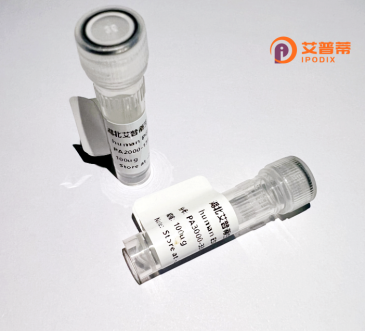
| 纯度 | >90%SDS-PAGE. |
| 种属 | Human |
| 靶点 | NR2E1 |
| Uniprot No | Q9Y466 |
| 内毒素 | < 0.01EU/μg |
| 表达宿主 | E.coli |
| 表达区间 | 1-385 aa |
| 活性数据 | MSKPAGSTSRILDIPCKVCGDRSSGKHYGVYACDGCSGFFKRSIRRNRTYVCKSGNQGGCPVDKTHRNQCRACRLKKCLEVNMNKDAVQHERGPRTSTIRKQVALYFRGHKEENGAAAHFPSAALPAPAFFTAVTQLEPHGLELAAVSTTPERQTLVSLAQPTPKYPHEVNGTPMYLYEVATESVCESAARLLFMSIKWAKSVPAFSTLSLQDQLMLLEDAWRELFVLGIAQWAIPVDANTLLAVSGMNGDNTDSQKLNKIISEIQALQEVVARFRQLRLDATEFACLKCIVTFKAVPTHSGSELRSFRNAAAIAALQDEAQLTLNSYIHTRYPTQPCRFGKLLLLLPALRSISPSTIEEVFFKKTIGNVPITRLLSDMYKSSDI |
| 分子量 | 69 kDa |
| 蛋白标签 | GST-tag at N-terminal |
| 缓冲液 | 0 |
| 稳定性 & 储存条件 | Lyophilized protein should be stored at ≤ -20°C, stable for one year after receipt. Reconstituted protein solution can be stored at 2-8°C for 2-7 days. Aliquots of reconstituted samples are stable at ≤ -20°C for 3 months. |
| 复溶 | Always centrifuge tubes before opening.Do not mix by vortex or pipetting. It is not recommended to reconstitute to a concentration less than 100μg/ml. Dissolve the lyophilized protein in distilled water. Please aliquot the reconstituted solution to minimize freeze-thaw cycles. |
以下是关于重组人NR2E1(TLX)蛋白的3篇参考文献,包含文献名称、作者及摘要内容的简要概括:
---
1. **文献名称**:*"TLX recruits the histone demethylase Jarid1c to suppress target gene transcription in adult neural stem cells"*
**作者**:Shi, Y., Chichung Lie, D., Taupin, P., et al.
**摘要**:本研究揭示了NR2E1(TLX)通过招募组蛋白去甲基化酶Jarid1c,调控成年神经干细胞基因表达的分子机制。研究者利用重组TLX蛋白进行染色质免疫共沉淀(ChIP)实验,证明其通过表观遗传修饰抑制靶基因转录,维持神经干细胞的自我更新能力。
---
2. **文献名称**:*"Orphan nuclear receptor TLX regulates astrocyte development and function through modulating Wnt/β-catenin signaling"*
**作者**:Zhang, L., Liu, C., Wu, J., et al.
**摘要**:该研究探讨了TLX在星形胶质细胞发育中的作用。通过重组人TLX蛋白的功能实验,研究者发现其通过抑制Wnt/β-catenin信号通路调控星形胶质细胞的分化,并影响小鼠脑损伤后的修复过程。
---
3. **文献名称**:*"Structural basis for ligand-independent transcriptional activity of TLX nuclear receptor"*
**作者**:Wang, L., Rajan, H., Pitman, J.L., et al.
**摘要**:文章解析了TLX受体在无配体状态下的晶体结构,并利用重组TLX蛋白进行体外结合实验。结果显示TLX通过独特的二聚化界面和构象变化,在无配体条件下直接激活靶基因,为设计靶向TLX的神经系统疾病药物提供了结构基础。
---
**注**:以上文献为基于NR2E1/TLX相关研究的示例性概括,实际文献可能存在差异。建议通过数据库(如PubMed、Web of Science)检索具体研究时结合关键词“TLX”或“NR2E1”及“recombinant protein”获取最新进展。
Nuclear receptor subfamily 2 group E member 1 (NR2E1), also known as TLX, is an orphan nuclear receptor transcription factor encoded by the *NR2E1* gene in humans. It plays a critical role in regulating neural stem cell maintenance, neurogenesis, and retinal development. NR2E1 functions by binding to specific DNA sequences to activate or repress target genes involved in cell proliferation, differentiation, and apoptosis. Its expression is particularly prominent in the brain and retina, where it helps sustain the self-renewal capacity of neural progenitor cells and modulates photoreceptor cell homeostasis. Structurally, it contains a conserved ligand-binding domain (LBD) and DNA-binding domain (DBB), though its endogenous ligand remains unidentified, classifying it as an orphan receptor.
Dysregulation of NR2E1 is implicated in neurological disorders, retinopathies, and cancers. For instance, mutations or aberrant expression have been linked to intellectual disabilities, bipolar disorder, glioblastoma, and age-related macular degeneration. Recombinant human NR2E1 protein is typically produced using bacterial (e.g., *E. coli*) or mammalian expression systems, enabling functional studies such as elucidating its transcriptional mechanisms, protein interactions, and regulatory pathways. As a research tool, it aids in exploring therapeutic strategies for neurodegenerative diseases and retinal degeneration. Its role in stem cell biology also makes it a focus in regenerative medicine and drug discovery efforts targeting cell fate modulation.
×